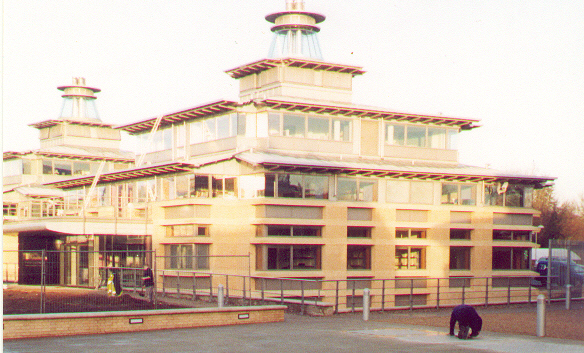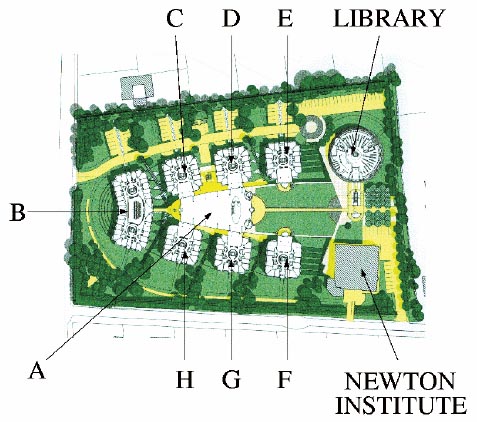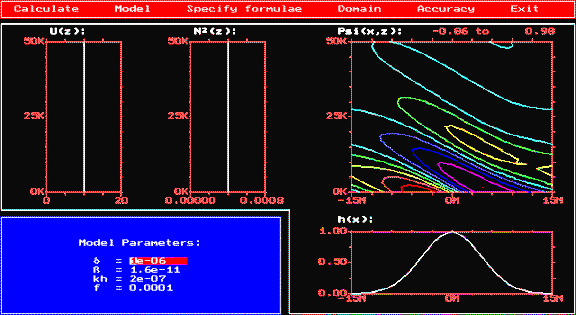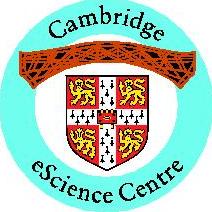
|

Construction of pavilion E, the Faulkes Institute for Geometry,
was completed in January 2002.
| Professor Raymond Lickorish, Head of the Department of Pure Mathematics and Mathematical Statistics, writes: |
In the repertoire of modern mathematics, the subject of Geometry still occupies a central key position. Geometrical thinking dominates a great deal of creative mathematical research, in which a new theory begins with an intuitive visual idea, about the placement of objects in space, that is then transformed into a rigorous logical argument. The ancient spirit of Euclidean Geometry, whereby a result is incontrovertibly proved from a stated set of axioms and previously proved theorems (to the profound satisfaction of its author), is still the essence of the whole of pure mathematics today. Interpreting Geometry as the part of mathematics motivated by the desire to understand the nature of different types of space, modern Geometry includes a variety of different topics which will be pursued by different, but overlapping, research groups within the Institute for Geometry. Within western civilisation, all these areas have developed, over many centuries, from classical Greek geometry. A deep appreciation of Euclidean Geometry is undoubtedly a necessity for modern geometers. The vibrant geometrical activity within the Institute will interact with the Millennium Mathematics Project, situated elsewhere in the Centre, to help encourage the teaching and learning of basic Geometry in British schools.

| Research Excellence |
The University of Cambridge is delighted that all three of its units of assessment in mathematics, Pure Mathematics, Applied Mathematics, Statistics and Operational Research, were awarded the top grade of 5* in the recently completed Research Assessment Exercise. Cambridge is the only University for which that is true. Coupled with the fact that the combined total of research-active staff submitted in the three units (114.5) is 29% greater than the next largest (Oxford), this is further proof, if such proof were needed, that Cambridge mathematics remains the best in the UK.
| The Research Assessment Exercise |
is the national scrutiny procedure for evaluating the quality of university research. Teams of experts assess departments on a number of different factors, including the submitted publications of active researchers. Scores are ranked from 1 to 5*, with 5* given only to exceptional departments which have reached levels of international excellence in the majority of their subject areas, and national excellence in all others.
| The MPhil in Statistical Science and CMS Dr Patricia M. E. Altham, Department of Pure Mathematics and Mathematical Statistics http://www.statslab.cam.ac.uk |
The MPhil in Statistical Science course ran for the first time in 1998-9. The Statistical Laboratory has been teaching statistics to graduate students since 1947, and from 1965-2000 was housed in Mill Lane, in the former warehouse of Cambridge University Press, converted by the University as a 'temporary' measure in 1965.
Two of the recent developments that have greatly enhanced our new MPhil course are the following: (i) the growth in the use of the world wide web. We started using this, for example to publicise our courses, in about 1995. This has proved to be a wonderful resource in the context of attracting new graduate students to Cambridge, particularly from overseas. Our web-page address is http://www.statslab.cam.ac.uk
(ii) the move to our wonderful new buildings in the Centre for Mathematical Sciences in April 2001. Our previous building had been very cramped, with facilities for students that, frankly, were not attractive. We now have a beautiful Library, magnificent lecture rooms, a spacious computer teaching room which is both comfortable and quiet, and a separate study room for the MPhil students with their own small reference library.
The entry requirements for our MPhil students are stringent, since students must have a very good background in Mathematics, and good English (they will need to write an MPhil dissertation in due course). Our MPhil students have come from the UK, Ireland, France, Germany, Luxembourg, Portugal, Cyprus, Malta, USA, Jamaica, Guyana, Singapore, India, China, Hong Kong, Kenya, Nigeria, Ghana and Togo.

MPhil students attending a practical class in our modern Computer Teaching Room
Photograph courtesy of Julia Blackwell
A distinguishing characteristic of the MPhil course is the Applied Project: each student is assigned a practical problem on which to cut his/her teeth, statistically speaking. There has been considerable demand by the MPhil students for projects arising from the world of banking/finance/insurance, and we are fortunate to be able to draw on the help of former students of the Laboratory, and others in the world of finance, who are willing to provide and supervise such projects. But there are several other fields from which projects naturally arise, for example econometrics, medical statistics, networks theory, educational statistics and traffic studies. Of course all of these are subjects that provide employment for statistically trained graduates, and our MPhil students do enjoy excellent employment prospects.
For example, here are the titles of some recent MPhil Projects: the summaries of these projects may be seen on our web-page. 'Extreme-value analysis of temperature in the Antarctic, 1950-95', a project concerned with the construction of models to characterise extreme environmental events; 'The effect of single room heat recovery ventilation on asthmatic children', which analysed data from a new technique aimed to improve the air supply in the bedrooms of known asthmatics; 'Simulation and analysis of aggregate claims and ruin probabilities for a perturbed classical risk model' to investigate the problems faced by insurance companies in setting their premiums; 'Modelling of house prices in English regions, 1968-97': can we fit a model that will help us to predict future house-prices? 'Modelling the association between growth patterns and mode of feeding in a Longitudinal study of Cambridge infants': three different diets (bottle-fed, breast-fed, and mixture) were compared by studying the growth records of 1094 babies born in the city of Cambridge over a given 6-year span; 'Factor analysis with arbitrage pricing restrictions', the aim being to find a model explaining stock movements, for data from the FTSE 350 index; 'An Options-theoretic approach to valuing hedge-fund management fees: analysis and implications': on what basis should a hedge-fund manager be paid? 'Acceptance policies in telephony gateways': relating to the problem of finding effective congestion control mechanisms for Internet traffic.
There is generally a good 'esprit de corps' among the MPhil students, considerably aided by the possibility of lingering over meals and cups of coffee in our Central Core dining area. Indeed some graduate students at the CMS seem happy to make the Central Core area their 'base' for working during the day-time, between lectures, classes and supervisions, and it is a real pleasure to see this large space, which is light, warm and cheerful, put to good use, particularly during the murky Cambridge winter days.
| GEFD Summer School Professor Peter Haynes, Department of Applied Mathematics and Theoretical Physics (DAMTP) |
The problems of understanding naturally occurring flows such as those in the atmosphere, ocean and the Earth's interior have been an important motivation and stimulation for development of fluid dynamics. This has been particularly true in Cambridge, where eminent scientists of the past, such as Taylor, Jeffreys and Lighthill, turned their attention to such problems. DAMTP members continue to perform leading-edge research in this area, some of which has been described in recent editions of Asymptopia.
Powerful computers, new observing techniques such as remote sensing by satellite and pressures to address problems of environmental change and conservation of scarce natural resources have led to a rapid expansion in quantitative, physically based, environmental science. Fluid dynamics is at the heart of many aspects of such science, but is often neglected in or omitted from the curriculum in mathematics, physics and chemistry undergraduate courses.
In 1991 the National Environment Research Council, the main funding body for environmental research in the UK, appointed DAMTP to hold an annual summer school in Geophysical and Environmental Fluid Dynamics, in order to allow young UK scientists in meteorology, oceanography and earth sciences to benefit from the expertise of DAMTP staff in relevant areas of fluid dynamics. The first summer school was held in September 1991, attended by 48 students, and the school has now been held each September since, with the 12th school planned for the coming September. This will be the last to be held in the old Silver Street building. In 2003 the summer school will move to take advantage of the completed facilities at the CMS.

Students studying the properties of surface waves in the Silver Street laboratory wave tank. Students work in groups, doing a different experiment on each afternoon that they are in the laboratory. At the end of the School, the groups give presentations on their results from one of the experiments.
Photograph courtesy of Dr Mark Hallworth.
The school is built around five or six series of core lectures (usually from DAMTP staff members). The emphasis is on basic fluid dynamical principles, with geophysical applications serving as important examples. The aim is clear explanation of these principles using a light mathematical touch (appropriate to the relatively broad range of academic backgrounds of the students) and illustrated as much as possible by images (slides, movies, videos) and, sometimes, by demonstration experiments. Students spend each afternoon of the school either in the fluid dynamics laboratory (see Figure 1), where they undertake a specially designed set of experiments, or in the computer room, where they have access to a suite of interactive demonstrations (see Figure 2). The laboratory experiments are always extremely well received and it is evident that for many students it is in carrying out the experiments that fluid dynamics turns from a dry, and difficult, subject to one that is fascinating and intuitive. The programme is augmented each year by a set of invited lecturers, who cover a range of special topics. Over the years, many leading international figures in atmospheric, oceanic or earth science have lectured at the school.

Students view of one of the suite of GEFD computer demonstrations, showing height-longitude cross-section of flow over topography. Parameters, background flow profiles etc can be changed to allow students to explore the range of behaviour. The demonstrations, which run on PCs, may be downloaded from http://gefd-www.damtp.cam.ac.uk
Whilst the school is, in a sense, a national summer school, with many students from the UK research community, it is also highly international (and this aspect is very important to those of us involved in running the school). A substantial minority come from other countries in Europe and from further afield. Around 600 students have now attended a DAMTP GEFD summer school and many are now well-established independent scientists. An enjoyable feature of attending large international conferences these days is the high probability of meeting up with former GEFD students and learning about how their careers are developing. There is no doubt, therefore, that the GEFD summer school has already had a lasting effect on the environmental research community in the UK and abroad and has been a truly worthwhile activity.
| The Last Wooden Spoon |
 Photograph courtesy of Tim Rawle. |
This is an edited version of a recent speech to the Friends of Mathematics given by Hugh Stewart (St John's 1947). Mr Stewart is probably uniquely qualified in his subject, being a member of the Lady Margaret Boat Club, a classicist manqué, an acquaintance of C L Holthouse and G P Easten, and a Junior Optime. Despite the latter, he qualified as an actuary and became company secretary of Equity & Law. |
The Mathematical Tripos (or rather Part II of the Tripos, the examination on which the class of the degree is based) has its own esoteric terminology: those who gain first class honours are Wranglers, second class honours Senior Optimes and third class honours Junior Optimes.
Nowadays the results are published in alphabetical order within the three classes but, until 1909, the names of successful candidates were listed, with their marks, in a full order of merit, starting with the Senior Wrangler, Second Wrangler, Third Wrangler and so on down to the lowest of the Junior Optimes who was nicknamed the Wooden Spoon. When they received their degrees from the Vice Chancellor in the Senate House they were presented in this order. Naturally the Senior Wrangler received great applause and the Wooden Spoon ironic cheers. An unofficial practice grew up for friends of the Wooden Spoon to get into the north and south galleries in the Senate House with a cord stretched between them from which a large wooden spoon was suspended over the candidate's head as he knelt before the Vice Chancellor.
The winner of the Wooden Spoon in 1909 was Cuthbert Lempriere Holthouse of St John's, a keen oarsman who had rowed for three years in the First May Boat of the Lady Margaret Boat Club. As this was to be the last ever Wooden Spoon his friends resolved to mark the occasion and commissioned a truly splendid one. The handle is made of the blade and shaft (reversed) of a scarlet Lady Margaret oar bearing an epigram in Greek which may be translated:
This is the very last of all
The Wooden Spoons which you see here;
O you who see it, shed a tear.
The 'bowl' is flat with a raised edge and is shaped rather like the ace of spades; it is also coloured scarlet. The main decoration consists of the College coat of arms, with the Eagle crest, the Yale supporters, and the boat club motto 'Si Je Puis'. The words 'Mathematical Tripos 1909' appear in a scroll next to the handle and the initials 'CLH' at the top.
C L Holthouse became a Church of England clergyman in 1910 and served in both Canada and England. He was Rural Dean of Chertsey 1946-1949 and died in 1967, aged 79. He had always preserved the Last Wooden Spoon but it was too large for him to take to a retirement home when he had to sell his house. By a strange coincidence one viewer of the house was Guthrie Philip Easten, also from St John's (who died in 2001, aged 91). He too was an eminent Lady Margaret oarsman (winning the Ladies' Plate at Henley in 1930) and immediately recognised the Last Wooden Spoon from the description in the boat club history. He suggested to C L Holthouse that he might offer the Spoon to St John's which gratefully accepted it. The Last Wooden Spoon now hangs in the College's Small Combination Room.
| Cambridge eScience Centre |
The Centre for Mathematical Sciences is host to the new Cambridge eScience Centre, one of eight regional centres set up by the government to promote research that needs massive computing resources and which will help to develop the Grid, the next generation of the Internet. Our region covers the whole of East Anglia and extends as far west as Buckingham and Leicester.

The Centre provides funding for research projects, technical expertise and access to high-powered computing facilities. The research projects cover a wide range of topics in science, technology and medicine. The first one to be approved, from the West Anglia Cancer Network, is a pilot project to use sophisticated videoconferencing facilities to allow patients to be diagnosed and treated by specialists located in various centres around the region. Other projects under consideration include studies of aircraft icing (Cranfield University), and the disposal of radiactive waste (Department of Earth Sciences, Cambridge University).
Very recently, the CMS has also been chosen by the National Environment Research Council as the site for its new National Institute for Environmental eScience. This is another multidisciplinary initiative for the application of Grid technology to the development of coupled, integrated earth-system models based on the large amount of satellite and other data that new observational techniques are providing.
| For information on making a donation in support of any aspect of Mathematics at Cambridge, please contact Professor Peter Landshoff P.V.Landshoff@damtp.cam.ac.uk or Patrick Hawke-Smith ph250@cam.ac.uk. |
